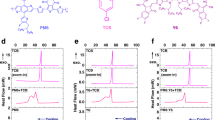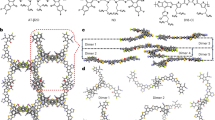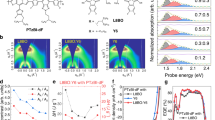Abstract
The crystallization dynamics of non-fullerene acceptors influences the morphology and charge dynamics of the resulting organic solar cells, ultimately determining device performance. However, optimizing the molecular arrangement of donor and acceptor materials within the active layer remains challenging. Here we control the crystallization kinetics of non-fullerene acceptors with a crystallization-regulating agent, acenaphthene. Acenaphthene changes the self-organization of acceptor molecules by inducing a two-step crystallization: it first fixes the packing motif of the acceptor and then refines the crystallized framework, leading to highly oriented acceptors in the active layer. This forms several charge-transport pathways that improve the charge-transport properties of the device. As a result, efficiencies of 20.9% (20.4% certified) and 21% (20.5% certified) are achieved in D18/L8-BO and PM1/L8-BO-X binary organic solar cells, respectively, with a maximum fill factor of 83.2% (82.2% certified). The result is a step forward in the development of organic solar cells.
This is a preview of subscription content, access via your institution
Access options
Access Nature and 54 other Nature Portfolio journals
Get Nature+, our best-value online-access subscription
$32.99 / 30 days
cancel any time
Subscribe to this journal
Receive 12 digital issues and online access to articles
$119.00 per year
only $9.92 per issue
Buy this article
- Purchase on SpringerLink
- Instant access to full article PDF
Prices may be subject to local taxes which are calculated during checkout






Similar content being viewed by others
Data availability
The data that support the findings of this study are available within the Article and its Supplementary Information. Source data are provided with this paper.
References
Lin, Y. et al. An electron acceptor challenging fullerenes for efficient polymer solar cells. Adv. Mater. 27, 1170–1174 (2015).
Yuan, J. et al. Enabling low voltage losses and high photocurrent in fullerene-free organic photovoltaics. Nat. Commun. 10, 570 (2019).
Yuan, J. et al. Single-junction organic solar cell with over 15% efficiency using fused-ring acceptor with electron-deficient core. Joule 3, 1140–1151 (2019).
Zhang, M., Guo, X., Ma, W., Ade, H. & Hou, J. A large‐bandgap conjugated polymer for versatile photovoltaic applications with high performance. Adv. Mater. 27, 4655–4660 (2015).
Sun, C. et al. A low cost and high performance polymer donor material for polymer solar cells. Nat. Commun. 9, 743 (2018).
Liu, Q. et al. 18% efficiency organic solar cells. Sci. Bull. 65, 272–275 (2020).
Fu, J. et al. Rational molecular and device design enables organic solar cells approaching 20% efficiency. Nat. Commun. 15, 1830 (2024).
Sun, K. et al. The role of solvent vapor annealing in highly efficient air-processed small molecule solar cells. J. Mater. Chem. A 2, 9048–9054 (2014).
Fu, J. et al. A ‘σ-hole’-containing volatile solid additive enabling 16.5% efficiency organic solar cells. iScience 23, 100965 (2020).
McDowell, C., Abdelsamie, M., Toney, M. F. & Bazan, G. C. Solvent additives: key morphology-directing agents for solution-processed organic solar cells. Adv. Mater. 30, 1707114 (2018).
Liu, H. et al. Dual‐additive‐driven morphology optimization for solvent‐annealing‐free all‐small‐molecule organic solar cells. Adv. Funct. Mater. 33, 2303307 (2023).
Fu, J. et al. 19.31% binary organic solar cell and low non-radiative recombination enabled by non-monotonic intermediate state transition. Nat. Commun. 14, 1760 (2023).
Liu, K. et al. 19.7% efficiency binary organic solar cells achieved by selective core fluorination of nonfullerene electron acceptors. Joule 8, 835–851 (2024).
Wang, L. et al. Donor–acceptor mutually diluted heterojunctions for layer-by-layer fabrication of high-performance organic solar cells. Nat. Energy 9, 208–218 (2024).
Tu, L. et al. Cyano-functionalized pyrazine: an electron-deficient unit as a solid additive enables binary organic solar cells with 19.67% efficiency. Energy Environ. Sci. 17, 3365–3374 (2024).
Guan, S. et al. Self‐assembled interlayer enables high‐performance organic photovoltaics with power conversion efficiency exceeding 20%. Adv. Mater. 36, 2400342 (2024).
Jiang, Y. et al. Non-fullerene acceptor with asymmetric structure and phenyl-substituted alkyl side chain for 20.2% efficiency organic solar cells. Nat. Energy 9, 975–986 (2024).
Li, G. et al. High-efficiency solution processable polymer photovoltaic cells by self-organization of polymer blends. Nat. Mater. 4, 864–868 (2005).
Qin, J. et al. 17% efficiency all-small-molecule organic solar cells enabled by nanoscale phase separation with a hierarchical branched structure. Energy Environ. Sci. 14, 5903–5910 (2021).
Zhan, L. et al. Layer‐by‐layer processed ternary organic photovoltaics with efficiency over 18%. Adv. Mater. 33, 2007231 (2021).
Zhang, Y. et al. Graded bulk-heterojunction enables 17% binary organic solar cells via nonhalogenated open air coating. Nat. Commun. 12, 4815 (2021).
Qin, J. et al. Volatile solid additive‐assisted sequential deposition enables 18.42% efficiency in organic solar cells. Adv. Sci. 9, 2105347 (2022).
Zhang, Y. et al. Achieving 19.4% organic solar cell via an in situ formation of pin structure with built-in interpenetrating network. Joule 8, 509–526 (2024).
Wu, W. et al. Defining solid additive’s pivotal role on morphology regulation in organic solar cells produced by layer‐by‐layer deposition. Adv. Energy Mater. 14, 2400354 (2024).
Lai, H. et al. Exploring the significance of packing modes and 3D framework sizes and utilizing three chlorine-mediated acceptors and the ‘like dissolves like’ approach for achieving an efficiency over 19. Energy Environ. Sci. 16, 5944–5955 (2023).
Lai, H. et al. Crystallography, packing mode, and aggregation state of chlorinated isomers for efficient organic solar cells. CCS Chem. 5, 1118–1129 (2023).
Fu, J. et al. Eutectic phase behavior induced by a simple additive contributes to efficient organic solar cells. Nano Energy 84, 105862 (2021).
Gutierrez‐Fernandez, E. et al. Y6 organic thin‐film transistors with electron mobilities of 2.4 cm2 V−1 s−1 via microstructural tuning. Adv. Sci. 9, 2104977 (2022).
Verploegen, E. et al. Effects of thermal annealing upon the morphology of polymer–fullerene blends. Adv. Funct. Mater. 20, 3519–3529 (2010).
Cui, Y. et al. Single‐junction organic photovoltaic cells with approaching 18% efficiency. Adv. Mater. 32, 1908205 (2020).
Sun, X. et al. Binary organic solar cells with >19.6% efficiency: the significance of self-assembled monolayer modification. ACS Energy Lett. 9, 4209–4217 (2024).
Zhan, L. et al. Desired open-circuit voltage increase enables efficiencies approaching 19% in symmetric-asymmetric molecule ternary organic photovoltaics. Joule 6, 662–675 (2022).
Qin, Y. et al. The performance-stability conundrum of BTP-based organic solar cells. Joule 5, 2129–2147 (2021).
Chen, S. et al. Photo‐carrier recombination in polymer solar cells based on P3HT and silole‐based copolymer. Adv. Energy Mater. 1, 963–969 (2011).
Zhao, Z. et al. Suppressing bimolecular charge recombination and energetic disorder with planar heterojunction active layer enables 18.1% efficiency binary organic solar cells. ACS Mater. Lett. 5, 1718–1726 (2023).
Ni, Z. et al. Resolving spatial and energetic distributions of trap states in metal halide perovskite solar cells. Science 367, 1352–1358 (2020).
Dela Peña, T. A. et al. Manipulating the charge carriers through functionally bridged components advances low‐cost organic solar cells with green solvent processing. Adv. Energy Mater. 14, 2303169 (2024).
Peña, T. A. D. et al. Interface property–functionality interplay suppresses bimolecular recombination facilitating above 18% efficiency organic solar cells embracing simplistic fabrication. Energy Environ. Sci. 16, 3416–3429 (2023).
Xia, X. et al. Revealing the crystalline packing structure of Y6 in the active layer of organic solar cells: the critical role of solvent additives. J. Mater. Chem. A 11, 21895–21907 (2023).
Zhang, G. et al. Delocalization of exciton and electron wavefunction in non-fullerene acceptor molecules enables efficient organic solar cells. Nat. Commun. 11, 3943 (2020).
Kupgan, G., Chen, X. & Bredas, J.-L. Molecular packing of non-fullerene acceptors for organic solar cells: distinctive local morphology in Y6 vs. ITIC derivatives. Mater. Today Adv. 11, 100154 (2021).
Yuk, D. et al. Simplified Y6‐based nonfullerene acceptors: in‐depth study on molecular structure–property relation, molecular dynamics simulation, and charge dynamics. Small 19, 2206547 (2023).
Cai, G. et al. Deuteration-enhanced neutron contrasts to probe amorphous domain sizes in organic photovoltaic bulk heterojunction films. Nat. Commun. 15, 2784 (2024).
Lindon, J. C., Tranter, G. E. & Koppenaal, D. Encyclopedia of Spectroscopy and Spectrometry 3rd edn (Academic Press, 2016).
Frisch, M. J. et al. Gaussian 16 (Gaussian, 2016).
Bannwarth, C. et al. Extended tight‐binding quantum chemistry methods. Wiley Interdiscip. Rev.: Comput. Mol. Sci. 11, e1493 (2021).
Li, C. et al. Non-fullerene acceptors with branched side chains and improved molecular packing to exceed 18% efficiency in organic solar cells. Nat. Energy 6, 605–613 (2021).
Cui, Y. et al. Organic photovoltaic cell with 17% efficiency and superior processability. Natl Sci. Rev. 7, 1239–1246 (2020).
Wu, J. et al. Random terpolymer based on thiophene-thiazolothiazole unit enabling efficient non-fullerene organic solar cells. Nat. Commun. 11, 4612 (2020).
Luo, S. et al. Auxiliary sequential deposition enables 19%-efficiency organic solar cells processed from halogen-free solvents. Nat. Commun. 14, 6964 (2023).
Zhu, L. et al. Achieving 20.8% organic solar cells via additive-assisted layer-by-layer fabrication with bulk pin structure and improved optical management. Joule 8, 3153–3168 (2024).
Yu, Y. et al. Naphthalene diimide-based cathode interlayer material enables 20.2% efficiency in organic photovoltaic cells. Sci. China Chem. 67, 4194–4201 (2024).
Chen, Z. et al. 20.2% efficiency organic photovoltaics employing a π‐extension quinoxaline‐based acceptor with ordered arrangement. Adv. Mater. 36, 2406690 (2024).
Chen, H. et al. Organic solar cells with 20.82% efficiency and high tolerance of active layer thickness through crystallization sequence manipulation. Nat. Mater. 24, 444–453 (2025).
Chen, C. et al. Molecular interaction induced dual fibrils towards organic solar cells with certified efficiency over 20. Nat. Commun. 15, 6865 (2024).
Li, C. et al. Highly efficient organic solar cells enabled by suppressing triplet exciton formation and non-radiative recombination. Nat. Commun. 15, 8872 (2024).
Guan, S. et al. Fine-tuning the hierarchical morphology of multi-component organic photovoltaics via a dual-additive strategy for 20.5% efficiency. Energy Environ. Sci. 18, 313–321 (2025).
Acknowledgements
G.L. thanks the Research Grants Council of Hong Kong (GRF Grant No. 15211320, CRF C4005-22Y and the RGC Senior Research Fellowship Scheme (SRFS2223-5S01)), Hong Kong Polytechnic University (the Sir Sze-yuen Chung Endowed Professorship Fund (8-8480), RISE (Q-CDBK), G-SAC5, PRI (1-CD7X)) and Guangdong-Hong Kong-Macao Joint Laboratory for Photonic-Thermal-Electrical Energy Materials and Devices (GDSTC No. 2019B121205001). H. Li thanks the Sichuan Science and Technology Programme (Grant No. 2023NSFSC0990). We thank Y. Chen (Beijing Synchrotron Radiation Facility) and L. Wang (Beijing Zhongke Wanyuan Technology) for the in situ spin-coating GIWAXS experiments. This work was carried out with the support of the SSRF, beamline BL02U2. We thank SSRF BL02U2 for the 2D GIWAXS measurements.
Author information
Authors and Affiliations
Contributions
J.F. and G.L. conceived the study. J.F. fabricated the devices and performed most of the characterizations and analysis. H. Li and P.C. performed the in situ GIWAXS measurements and analysis. H. Liu and X.L. performed the ex situ GISAXS measurements and analysis. P.H. performed the density functional theory calculations. H.C., Z.X. and S.L. assisted with the NMR measurements and analysis. P.W.K.F. conducted the in situ UV–vis characterization. G.L. guided the study and supervised the execution. The paper was prepared, revised and finalized by J.F., H. Li, H. Liu and G.L. All authors discussed the results and commented on the paper.
Corresponding author
Ethics declarations
Competing interests
The authors declare no competing interests.
Peer review
Peer review information
Nature Energy thanks the anonymous reviewers for their contribution to the peer review of this work.
Additional information
Publisher’s note Springer Nature remains neutral with regard to jurisdictional claims in published maps and institutional affiliations.
Supplementary information
Supplementary Information
Supplementary Notes 1 and 2, Figs. 1–34 and Tables 1–6.
Supplementary Video 1
Time-resolved GIWAXS patterns of the control sample during spin-coating.
Supplementary Video 2
Time-resolved GIWAXS patterns of the AP sample during spin-coating.
Supplementary Video 3
Time-resolved GIWAXS patterns of the control sample during thermal annealing.
Supplementary Video 4
Time-resolved GIWAXS patterns of the AP sample during thermal annealing.
Supplementary Data
Source data for supplementary figures and tables.
Source data
Source Data Fig. 1
Statistical source data for Fig. 1.
Source Data Fig. 6
Statistical source data for Fig. 6.
Source Data Table 1
Statistical source data for Table 1.
Source Data Table 2
Statistical source data for Table 2.
Rights and permissions
Springer Nature or its licensor (e.g. a society or other partner) holds exclusive rights to this article under a publishing agreement with the author(s) or other rightsholder(s); author self-archiving of the accepted manuscript version of this article is solely governed by the terms of such publishing agreement and applicable law.
About this article
Cite this article
Fu, J., Li, H., Liu, H. et al. Two-step crystallization modulated through acenaphthene enabling 21% binary organic solar cells and 83.2% fill factor. Nat Energy (2025). https://doi.org/10.1038/s41560-025-01862-1
Received:
Accepted:
Published:
DOI: https://doi.org/10.1038/s41560-025-01862-1



